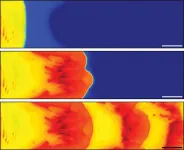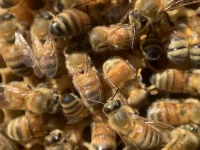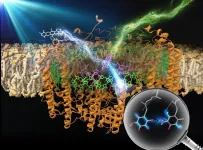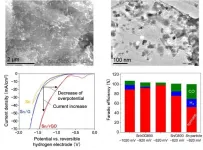Quantitative detection of fatty liver disease by assessing fat distribution in the liver
A noninvasive method for quantifying fat content in liver can aid medical research and diagnosis of liver diseases
2021-03-24
(Press-News.org) Nonalcoholic fatty liver disease (NAFLD) is a pathological condition characterized by excessive fat stored in the liver that is not attributed to heavy alcohol consumption, which can lead to liver failure and even cancer. Obesity, type 2 diabetes, and high cholesterol levels are all risk factors for this disease, and like the global prevalence of obesity, the prevalence of NAFLD is coincidently expected to rise as well.
It is therefore critical for clinicians to handle effective tools for diagnosing NAFLD. The current standard method for diagnosis is analysis of liver biopsy samples. However, this approach has shortcomings such as invasiveness and the potential for sampling errors, so there is a pressing need for reliable noninvasive methods. In a new study published in the journal Biomedical Optics Express, a team of researchers, led by Professor Kohei Soga of Tokyo University of Science including Assistant Professor Kyohei Okubo of Tokyo University of Science and Professor Naoko Ohtani of Osaka City University, reports the successful use of near-infrared hyperspectral imaging to quantitatively analyze the distributions of lipids (a class of lipids commonly found in fat) in mouse liver. Dr. Okubo says, "Lipid distribution in the liver provides crucial information for diagnosing fatty liver-associated liver diseases including cancer, and therefore, a noninvasive, label-free, quantitative modality is needed."
In describing the inspiration for this project, Dr. Okubo collaborated with Professor Ohtani, who studies the relationship between obesity and liver disease. Given the success of other research groups in using near-infrared hyperspectral imaging to visualize plaques in rabbit blood vessels and fatty acids in pork meats, Prof. Soga's team decided to try using it to visualize the distribution of lipids in mouse liver.
The study focused on mice that were either on a normal diet or one of three kinds of high-fat diets rich in various types of lipids. The objective of these varied diets was to generate a set of livers with diverse lipid profiles. After extracting the livers, the scientists used a reference test to generate convincing results for comparing their hyperspectral imaging results. They used the Folch extraction method to isolate lipids from small pieces of the livers and then weighed the isolated lipid samples to calculate the total weight of lipids within the livers. The scientists next performed near-infrared hyperspectral imaging and used two candidate data analysis methods--partial least-square regression and support vector regression--to quantitatively visualize lipid distributions within the liver to identify the better analytical method.
When the scientists examined their data, they found that it enabled them to image the livers in gradient colors according to the lipid levels contained in the livers and to generate maps of the local lipid densities within the livers. The lipid levels as measured with hyperspectral imaging closely correlated with the actual lipid levels as quantified based on Folch extraction method, and this correlation was stronger in the lipid levels calculated using support vector regression than for the lipid levels calculated using partial least square regression.
In articulating the significance of his team's research, Dr. Okubo notes, "We have developed a method to visualize the distribution of lipids in the liver using a near-infrared spectral imaging technique that incorporates machine learning." This is important because near-infrared spectral imaging technologies could be used for the noninvasive evaluation of the liver status, thus providing a diagnostic option for clinicians when investigating NAFLD cases. Near-infrared spectral imaging can also be used to detect specific lipid compound types, and Dr. Okubo is quick to emphasize that "the ultimate goal of this collaborative research is to differentiate and identify fatty acids in the liver." Achieving this future goal would represent a major advancement in research in fatty liver diseases.
INFORMATION:
About The Tokyo University of Science
Tokyo University of Science (TUS) is a well-known and respected university, and the largest science-specialized private research university in Japan, with four campuses in central Tokyo and its suburbs and in Hokkaido. Established in 1881, the university has continually contributed to Japan's development in science through inculcating the love for science in researchers, technicians, and educators.
With a mission of "Creating science and technology for the harmonious development of nature, human beings, and society", TUS has undertaken a wide range of research from basic to applied science. TUS has embraced a multidisciplinary approach to research and undertaken intensive study in some of today's most vital fields. TUS is a meritocracy where the best in science is recognized and nurtured. It is the only private university in Japan that has produced a Nobel Prize winner and the only private university in Asia to produce Nobel Prize winners within the natural sciences field.
Website: https://www.tus.ac.jp/en/mediarelations/
About Dr. Kyohei Okubo from Tokyo University of Science
Kyohei Okubo, PhD, is an Assistant Professor at Tokyo University of Science. He completed his undergraduate and postgraduate education at University of Tsukuba, and he has worked at the University of Tokyo and Innovation Center of NanoMedicine (iCONM), Japan. He has conducted research into photonic sensors, the fabrication of nanoplasmonic devices, nanoarray chips, and near-infrared bioimaging. He has authored 28 publications.
About Professor Kohei Soga from Tokyo University of Science
Kohei Soga, PhD, is a Professor at Tokyo University of Science. He completed his undergraduate and postgraduate education at the University of Tokyo. He has been focusing his research on the interdisciplinary fields of bio- and nano-photonics, with the aim to develop a biophotonic system with near-infrared excitation.
About Professor Naoko Ohtani from Osaka City University
Naoko Ohtani, MD, PhD, is a Professor at Osaka City University. She completed her undergraduate and postgraduate education at Kyoto Prefectural University of Medicine. She has been investigating the mechanism of cancer development, particularly of obesity-associated liver cancer, focusing on the tumor microenvironment and involvement of gut microbiota in liver diseases.
Funding information
This study was supported by the Japan Society for the Promotion of Science, the Japan Agency for Medical Research and Development, and the Japanese Ministry of Education, Culture, Sports, Science and Technology.
[Attachments] See images for this press release:

ELSE PRESS RELEASES FROM THIS DATE:
2021-03-24
Researchers led by TMDU fabricate a material that will aid bone healing, help medical practitioners clearly assess the full damage to bones after an injury, and clarify probable patient outcomes
Tokyo, Japan - Bone repair wasn't generally successful until the late 1800s. Until then, there were few options to repair major bone damage. Most materials don't have the functionality of bone and don't support blood vessels growing through them. Repair materials such as clay were commonly used yet often failed. In 1892, medical practitioners started using gypsum--calcium ...
2021-03-24
Tobacco smoke-exposed children utilize emergency and urgent care services more often than unexposed children, which contributes to a large toll on the nation's health care system, says research led by the University of Cincinnati.
The study, recently published in the journal PLOS ONE, concluded:
· Children who are exposed to tobacco smoke have higher pediatric emergency department visit costs compared to unexposed children.
· A higher number of tobacco smoke-exposed children had an urgent care visit over a one-year period compared to unexposed children.
· Tobacco smoke-exposed children had nearly twice the risk of being admitted to the hospital over a one-year period compared to unexposed children. ...
2021-03-24
Floating solar farms could help to protect lakes and reservoirs from some of the harms of climate change, a new study suggests.
However, given the complex nature of water bodies and differing designs of solar technologies, there could also be detrimental ecosystem impacts of deploying floating solar arrays.
Conventional solar farms are controversial due to the amount of land they take up. This is leading to increasing interest in floating solar farms - making use of the additional space that bodies of water provide.
So far, there are three commercial-size floating solar arrays in the UK, and hundreds more across the world. The number of installations is likely to grow significantly in coming decades as demand rises for renewable energy sources with more countries committing ...
2021-03-24
For scientists, especially graduate students, who conduct fieldwork, every day is precious. Researchers meticulously prepare their equipment, procedures and timelines to make sure they get the data they need to do good science. So you can imagine the collective anxiety that fell across academia in spring 2020 when COVID-19 struck and many universities suspended in-person activities, including fieldwork.
But for Austin Green, a doctoral student in the School of Biological Sciences and 2019 recipient of a National Geographic Society Early Career Grant, who studies the wildlife that lives in the canyons of the Wasatch Front, that anxiety was tempered by the knowledge that pandemic or no pandemic, his network of automated ...
2021-03-24
The largest flightless bird ever to live weighed in up to 600kg and had a whopping head about half a metre long - but its brain was squeezed for space.
Dromornis stirtoni, the largest of the 'mihirungs' (an Aboriginal word for 'giant bird'), stood up to 3m high and had a cranium wider and higher than it was long due to a powerful big beak, leading Australian palaeontologists to look inside its brain space to see how it worked.
The new study, just published in the journal Diversity, examined the brains of the extinct giant mihirungs or dromornithid birds that were a distinctive part of the Australian fauna for many millions of years, before going extinct around 50,000 ...
2021-03-24
During the COVID-19 pandemic, people have grown accustomed to wearing facemasks, but many coverings are fragile and not easily disinfected. Metal foams are durable, and their small pores and large surface areas suggest they could effectively filter out microbes. Now, researchers reporting in ACS' Nano Letters have transformed copper nanowires into metal foams that could be used in facemasks and air filtration systems. The foams filter efficiently, decontaminate easily for reuse and are recyclable.
When a person with a respiratory infection, such ...
2021-03-24
Nature produces a startling array of patterned materials, from the sensitive ridges on a person's fingertip to a cheetah's camouflaging spots. Although nature's patterns arise spontaneously during development, creating patterns on synthetic materials is more laborious. Now, researchers reporting in ACS Central Science have found an easy way to make patterned materials having complex microstructures with variations in mechanical, thermal and optical properties -- without the need for masks, molds or printers.
In animals, patterns form before birth ...
2021-03-24
Honeybees play a scent-driven game of telephone to guide members of a colony back to their queen, according to a new study led by University of Colorado Boulder. The research, published today in the Proceedings of the National Academy of Sciences, highlights how insects with limited cognitive abilities can achieve complex feats when they work together--even creating what looks like a miniature and buzzing version of a telecommunications network.
The findings also serve as a testament to a honeybee's love for its queen. These matriarchs are the most important members of any hive: They're the only females able ...
2021-03-24
Given the finite nature of fossil fuel reserves and the devastating environmental impacts of relying on fossil fuels, the development of clean energy sources is among the most pressing challenges facing modern industrial civilization. Solar energy is an attractive clean energy option, but the widescale implementation of solar energy technologies will depend on the development of efficient ways of converting light energy into chemical energy.
Like many other research groups, the members of Professor Takehisa Dewa's research team at Nagoya Institute of Technology in Japan have turned to biological photosynthetic apparatuses, which ...
2021-03-24
[Background]
Decreasing the emission and efficient utilization (fixation) of carbon dioxide (CO2) are worldwide issues to prevent global warming. Promotion of the use of renewable energy is effective in reducing CO2 emissions. However, since there are large time-dependent fluctuations and large regional differences in renewable energy production, it is necessary to establish a fixation technology to allow efficient energy transportation and storage. Thus, there is increasing interest in technologies for synthesizing useful chemicals from CO2 using electricity derived from renewable energy. ...
LAST 30 PRESS RELEASES:
[Press-News.org] Quantitative detection of fatty liver disease by assessing fat distribution in the liver
A noninvasive method for quantifying fat content in liver can aid medical research and diagnosis of liver diseases









